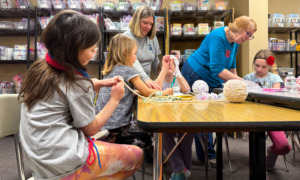This story was produced by The Hechinger Report, a nonprofit, nonpartisan news outlet focused on education.
Jolene Hunt-Fleming did not hesitate nearly 13 years ago when her daughter asked for help with her newborn baby son. She knew her daughter, a single parent, needed full-time child care to finish school and work.
Hunt-Fleming, who has worked for years as a mortgage funder and is certified in human services, also stepped in when the next three grandchildren – now ages 2, 6, and 9 – came along. My daughter “was very skeptical about other people watching her children,” said Hunt-Fleming, who lives in La Habra, California.
Although the work has been a personal joy, it’s also been a financial sacrifice. The grandmother learned quickly from the Children’s Home Society of California that the state offers subsidies for family caregivers, but the pay might well be below minimum wage. At one point, Hunt-Fleming — who cradled her 2-year-old granddaughter in her lap during most of our interview over Zoom — made only $1.79 an hour for the work. She currently earns about $2,800 each month from the state to watch the 2-year-old full time, and her siblings part-time. “If I wasn’t providing care for the children…I’m sure it would be substantially more that I would be bringing in,” she said.
[Related: Parents tote toddlers to D.C. to press for expanded child tax credit, child care funds]
Family, friend and neighbor caregivers, often referred to as “informal” care, are both underpaid and too often unable to access the money they are entitled to, according to a new policy brief from Early Edge California, which supports quality early learning opportunities for children from birth; the brief was produced in collaboration with several other groups. Between a third and a half of all children under the age of five receive informal care from a family member, friend or neighbor, making it the most common child care arrangement for this age group outside of parental care. Many of these caregivers are grandparents, like Hunt-Fleming.
In many states, informal caregivers are eligible for some form of funded support for their work, the most common being child care subsidies for children from low-income families. There are also state and locally-funded models for support. But nationally, less than 20 percent of the more than 4.5 million informal caregivers receive the subsidies or related payment, according to a 2022 report from the BUILD Initiative, which provides support to state leaders for early childhood programs. In California about one in four of informal caregivers go unpaid, the Early Edge report noted.
The California effort is just one example of growing momentum across the country to provide more resources and support for these caregivers, who have only become more essential after the pandemic contributed to a devastating loss in licensed child care spaces in many communities. In Colorado, a recent law makes it easier for immigrants and undocumented caregivers to access the subsidies, according to the BUILD Initiative report. Meanwhile, Louisiana has simplified the process for informal providers to become registered. And New Mexico took steps to provide them with significantly more public funding.
California is unusual in that informal caregivers can be part of the collective bargaining unit for home-based child care providers in the state, as long as the children in their care are eligible for subsidies. That said, they have historically been less organized and visible in policy debates than licensed home-based providers. “We saw the need to give them a voice,” said Patricia Lozano, executive director of Early Edge.
Scores of California caregivers don’t receive the state subsidies they are entitled to for a variety of reasons. “Many times there are language barriers,” Lozano said. And some caregivers “are afraid that their immigration status will impact whether they can get subsidies.”
The policy brief described several of the key barriers, including: mistrust over interacting with the government; fear of losing access to other government benefits; challenges navigating the enrollment system; and a lack of awareness.
The state needs to let more people know that financial support is available, Hunt-Fleming said. “It could start in the doctor’s office or the schools.”
The policy brief also provided recommendations for change and ramped up outreach. Those could include making multilingual posters and brochures available at libraries, parks and recreation services; technical assistance in navigating digital applications; and tax guidance so the caregivers don’t have to worry about jeopardizing other forms of government aid to access the subsidies.
“It’s important to acknowledge them and make them part of the system,” Lozano said. In California there’s a real need to raise the reimbursement rates for all types of child care providers, including informal ones, who currently receive 70 percent of what licensed family child care providers get, she added. “We can raise everybody,” she said. “The bar is so low right now.”
Hunt-Fleming doesn’t think she could make it work financially without a husband who brings in regular income. Besides the low pay, the reimbursement process can be slow. The state never processes subsidies toward the end of the month, when most people have rent and other payments due, she said. “That’s hard because I have bills,” she said.
Hunt-Fleming spends whatever hours she can on advocacy work for her colleagues through a program called California Leading from Home. After more than a decade spending her days changing diapers, taking kids to doctor appointments and helping the older ones with homework, she wants others in her situation — and policy makers, too — to view the work as more than a gesture of love. She wants them to see it as a real job.
***
Sarah Carr has reported and edited for Hechinger since 2011. Currently, she covers early childhood education and manages the eight-newsroom Education Reporting Collaborative. She has written for The Washington Post, The Atlantic and Slate, winning several national awards.




























